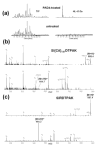Neutral loss of isocyanic acid in peptide CID spectra: a novel diagnostic marker for mass spectrometric identification of protein citrullination
- PMID: 19200748
- PMCID: PMC2786913
- DOI: 10.1016/j.jasms.2008.12.012
Neutral loss of isocyanic acid in peptide CID spectra: a novel diagnostic marker for mass spectrometric identification of protein citrullination
Abstract
Protein citrullination is emerging as an important signaling mechanism that modulates a variety of biological processes. This protein modification constitutes only a 1 Da mass shift, and can be readily confused with other common protein modifications that yield an identical mass shift. In an attempt to develop a robust methodology for detection of protein citrullination sites, we analyzed synthetic citrulline-containing peptides by electrospray ionization tandem mass spectrometry. Collision-induced dissociation (CID) spectra revealed abundant neutral loss of 43 Da from citrullinated peptide precursor ions, which was reconciled by elimination of the HNCO moiety (isocyanic acid) from the citrulline ureido group. The elimination occurs readily in multiple charge states of precursor ions and also in b and y ions. HNCO loss in CID spectra provides a novel diagnostic marker for citrullination, and its utility was demonstrated by the discovery of Arg197 as the specific site of citrullination on nucleophosmin upon peptidylarginine deiminase 4 treatment.
Figures


Similar articles
-
Mapping the tandem mass spectrometric characteristics of citrulline-containing peptides.Rapid Commun Mass Spectrom. 2018 Jun 15;32(11):844-850. doi: 10.1002/rcm.8105. Rapid Commun Mass Spectrom. 2018. PMID: 29575159
-
A Streamlined Data Analysis Pipeline for the Identification of Sites of Citrullination.Biochemistry. 2021 Sep 28;60(38):2902-2914. doi: 10.1021/acs.biochem.1c00369. Epub 2021 Sep 7. Biochemistry. 2021. PMID: 34491035 Free PMC article.
-
Targeted analysis of protein citrullination using chemical modification and tandem mass spectrometry.Rapid Commun Mass Spectrom. 2009 Sep;23(17):2754-62. doi: 10.1002/rcm.4185. Rapid Commun Mass Spectrom. 2009. PMID: 19639564
-
Chemical biology of protein citrullination by the protein A arginine deiminases.Curr Opin Chem Biol. 2021 Aug;63:19-27. doi: 10.1016/j.cbpa.2021.01.010. Epub 2021 Mar 4. Curr Opin Chem Biol. 2021. PMID: 33676233 Free PMC article. Review.
-
Role of Peptidylarginine Deiminase 4 in Central Nervous System Diseases.Mol Neurobiol. 2023 Nov;60(11):6748-6756. doi: 10.1007/s12035-023-03489-3. Epub 2023 Jul 22. Mol Neurobiol. 2023. PMID: 37480499 Review.
Cited by
-
Recent advances in characterization of citrullination and its implication in human disease research: From method development to network integration.Proteomics. 2023 Nov;23(21-22):e2200286. doi: 10.1002/pmic.202200286. Epub 2023 Jan 5. Proteomics. 2023. PMID: 36546832 Free PMC article. Review.
-
Citrullinated Inhibitor of DNA Binding 1 Is a Novel Autoantigen in Rheumatoid Arthritis.Arthritis Rheumatol. 2019 Aug;71(8):1241-1251. doi: 10.1002/art.40886. Epub 2019 Jun 21. Arthritis Rheumatol. 2019. PMID: 30861322 Free PMC article.
-
Hempseed Lignanamides Rich-Fraction: Chemical Investigation and Cytotoxicity towards U-87 Glioblastoma Cells.Molecules. 2020 Feb 26;25(5):1049. doi: 10.3390/molecules25051049. Molecules. 2020. PMID: 32110947 Free PMC article.
-
Constrained selected reaction monitoring: quantification of selected post-translational modifications and protein isoforms.Methods. 2013 Jun 15;61(3):304-12. doi: 10.1016/j.ymeth.2013.03.006. Epub 2013 Mar 22. Methods. 2013. PMID: 23523700 Free PMC article.
-
Brain Citrullination Patterns and T Cell Reactivity of Cerebrospinal Fluid-Derived CD4+ T Cells in Multiple Sclerosis.Front Immunol. 2019 Apr 10;10:540. doi: 10.3389/fimmu.2019.00540. eCollection 2019. Front Immunol. 2019. PMID: 31024521 Free PMC article.
References
-
- György B, Tóth E, Tarcsa E, Falus A, Buzás EI. Citrullination: a posttranslational modification in health and disease. Int J Biochem Cell Biol. 2006;38:1662–77. - PubMed
-
- Vossenaar ER, Zendman AJ, van Venrooij WJ, Pruijn GJ. PAD, a growing family of citrullinating enzymes: genes, features and involvement in disease. Bioessays. 2003;25:1106–18. - PubMed
-
- Wang Y, Wysocka J, Sayegh J, Lee YH, Perlin JR, Leonelli L, Sonbuchner LS, McDonald CH, Cook RG, Dou Y, Roeder RG, Clarke S, Stallcup MR, Allis CD, Coonrod SA. Human PAD4 regulates histone arginine methylation levels via demethylimination. Science. 2004;306:279–83. - PubMed
-
- Chavanas S, Méchin MC, Nachat R, Adoue V, Coudane F, Serre G, Simon M. Peptidylarginine deiminases and deimination in biology and pathology: relevance to skin homeostasis. J Dermatol Sci. 2006;44:63–72. - PubMed
Publication types
MeSH terms
Substances
Grants and funding
LinkOut - more resources
Full Text Sources
Other Literature Sources

